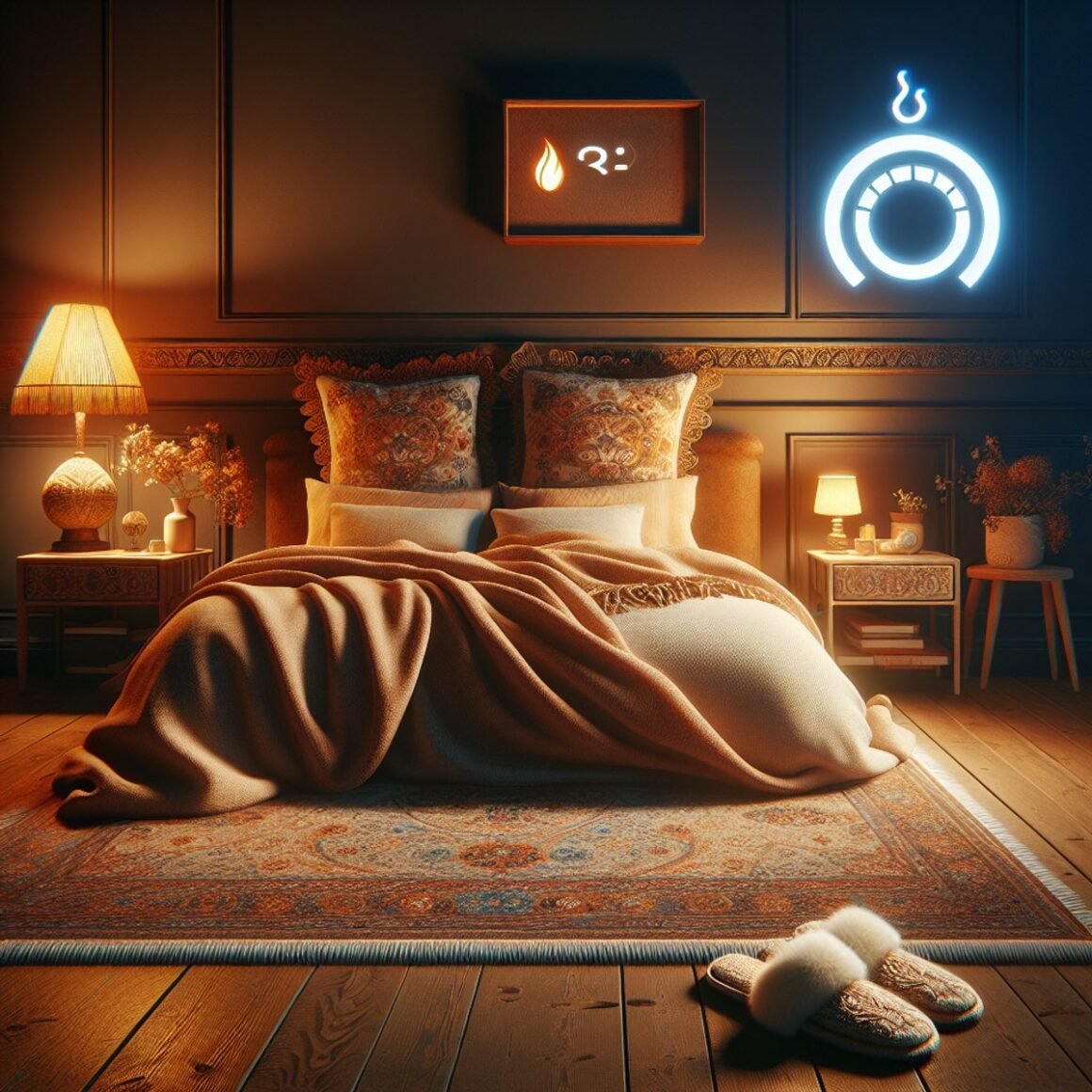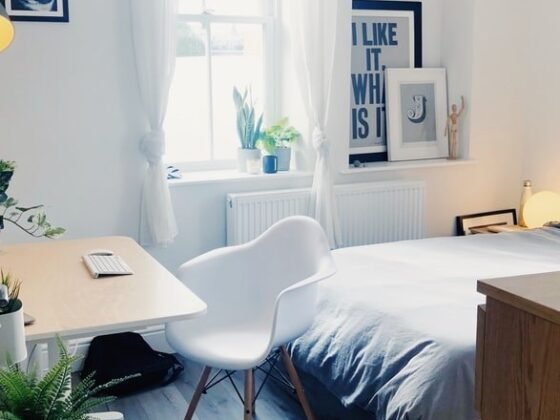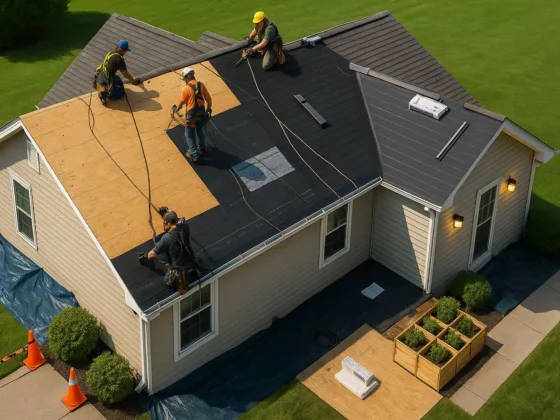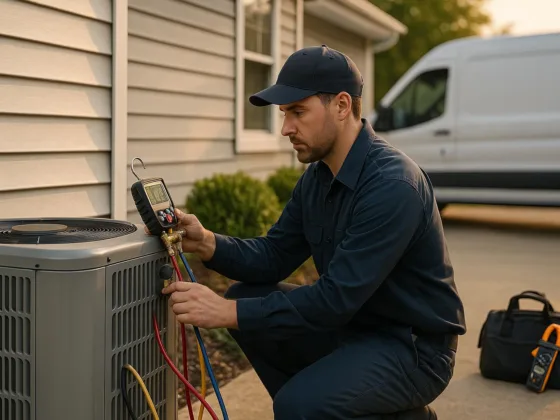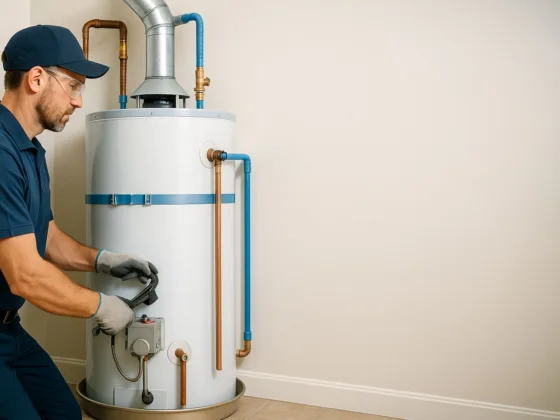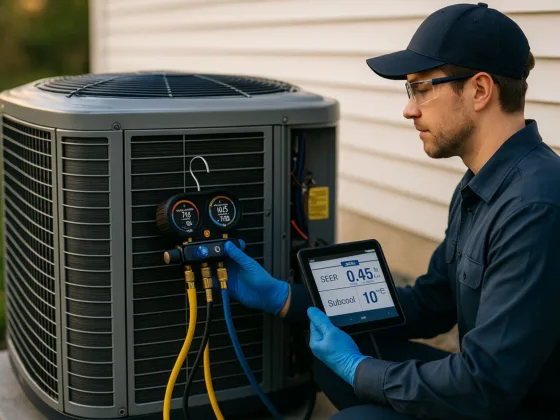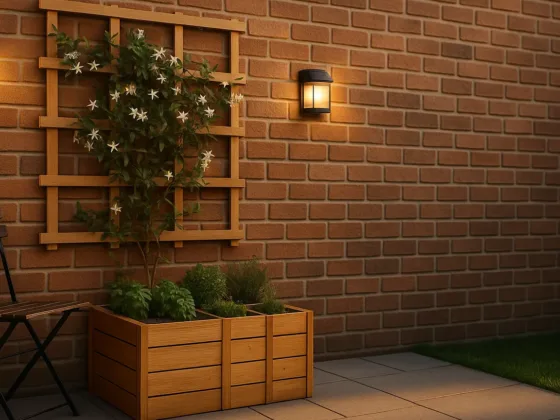Table of Contents Show
Introduction
When the sun dips and the moon takes its nightly throne, the quest for the perfect temperature setting becomes more than a mere comfort issue—it’s a dance of cost savings and energy conservation within your home. The mercury’s drop cues our heaters to rise to the occasion, where setting them just right can make all the difference.
The humble thermostat serves as our trusty sidekick in this endeavor. With precision and foresight, it governs our heater’s output through the twilight hours, ensuring we’re snug as bugs without burning through our wallets. It’s a tool that, when used wisely, can transform our nocturnal nest into a haven of warmth.
By dialing in on the optimal heater temperature at night, we tap into a trifecta of benefits:
- Comfort: Ensuring a cozy slumber without the chill.
- Energy Efficiency: Reducing unnecessary heating to conserve energy.
- Cost Savings & Environmental Sustainability: Lowering monthly bills while taking a stand for Mother Earth.
Striking this balance doesn’t just lead to sweet dreams; it embodies smart homeownership and an investment in our planet’s future.
Understanding the Optimal Heater Temperature at Night
As winter’s chill sets in, striking a harmony between coziness and conservation becomes the nightly puzzle. The quest for the ideal home temperature in winter is not just about personal comfort; it’s a balancing act with your wallet and the planet’s well-being in mind. So, what’s the magic number for that nighttime temperature?
Experts weigh in, suggesting that while 68°F (20°C) is acceptable during waking hours, dialing down to 65°F (18°C) to 62°F (16.5°C) can be conducive for sleep and energy savings. Every degree you lower in this range can translate to a notable reduction on your heating bill—cue the energy savings dance!
Here are some practical tips to keep warm without cranking up the heat:
- Layer Up: Don those fuzzy socks and flannel PJs. A warm blanket can be your best ally against the winter chills.
- Invest in Insulation: Good insulation keeps heat from escaping, meaning your heater works less to maintain that cozy feel.
- Use a Hot Water Bottle: An old-school method that works wonders. A hot water bottle at your feet can keep you snug as a bug.
- Close-Off Unused Rooms: Shutting doors to less-used spaces can keep heat where it’s needed most.
And remember, the right nighttime temperature also depends on your home’s specifics—think insulation quality, window types, and even ceiling height. It’s all about finding that sweet spot where winter energy efficiency meets personal preference without sacrificing those Zzzs. Adjustments might be small but think of them as steps on a staircase leading to an ideally heated haven for those long winter nights.
By managing your heater smartly, you’re not only embracing energy efficiency but also setting up for some dreamy slumber.
Factors to Consider for Setting the Right Heater Temperature
When you’re deciding on the perfect nighttime heater temperature, it’s important to think beyond just picking a number. There are a few key factors that can help you find the ideal balance between comfort and efficiency.
1. Personal Body Temperature Variations
Everyone has their own unique internal thermostat, which means what feels comfortable to one person might be too hot or too cold for another. Here are a couple of things to keep in mind:
- Chilly Sleepers: If you tend to feel cold at night, you might want to set your heater’s temperature a bit higher.
- Warm Sleepers: On the other hand, if you tend to get hot while you sleep, setting the thermostat lower can help prevent overheating.
2. Humidity Level’s Impact on Comfort and Heat Retention
Believe it or not, humidity can actually affect how warm or cold we feel. Here’s why it matters:
- High Humidity: When there’s a lot of moisture in the air, it can make it feel warmer than it actually is. However, it can also make things feel sticky and uncomfortable.
- Low Humidity: In contrast, low humidity often leads to dry air that can make it feel cooler. This means you might need to turn up the heat a bit to stay comfortable.
- Finding the Right Balance: Ideally, you want to aim for a humidity level that works well with your heater setting. This way, you can stay cozy without putting too much strain on your system.
3. HVAC System: Ensuring Stable Indoor Climates
Your HVAC system plays a crucial role in maintaining a comfortable home environment. Here’s how it can impact your nighttime heating:
- Quick Adjustments: A responsive HVAC system will be able to adapt quickly when temperatures fluctuate during the night. This can help ensure every room stays at the right temperature.
- Consistent Heating: A well-functioning system will also be able to provide even heating throughout the night, without any sudden blasts of hot or cold air.
- Saving Energy: When your HVAC system is running efficiently, it uses less energy to heat your home. This can lead to lower utility bills in the long run.
By taking these factors into account — including personal body temperature, humidity levels, and the effectiveness of your HVAC system — you’ll be able to find the perfect heater settings for your needs. It’s all about finding that balance between what feels good to you and what makes sense from an energy standpoint.
As we shift gears, let’s explore some strategies for making your nighttime heating more energy-efficient. After all, saving money while staying cozy is always a win-win!
Energy Efficiency Strategies for Nighttime Heater Use
When the temperature drops and it starts to get chilly, it’s time to use your heater. But before you make it super hot in your home, let’s talk about how to use your heater efficiently at night. The right nighttime temperature on your heater is not only about being comfortable; it’s also a smart way to save money and help the environment.
Aim for Long-term Savings
First, think about the bigger picture. Making small changes to your heater’s nighttime setting can lead to big energy savings without sacrificing comfort. It’s like going on a diet for your energy bill – make small changes here and there, and you’ll see a big difference in the long run.
Boost Your Heat Pump Efficiency
Heat pumps are great at saving energy, but they need some help too:
- Lower the Temperature: Decreasing the indoor temperature by a few degrees at night can make it easier for your heat pump to work efficiently.
- Take Care of Your Heat Pump: Just like any important equipment, it’s important to keep your heat pump in good shape. Cleaning the filters and coils regularly will help it work better.
- Use a Smart Thermostat: A thermostat that can learn your habits and adjust the heating schedule accordingly is a great investment. It will make sure you’re only using heat when you need it.
The Magic of Multi-Zone Heating Systems
Imagine this: you’re all cozy in bed, but you’re not wasting energy heating up rooms that you’re not using. That’s where a multi-zone heating system comes in handy. Here’s why they’re worth considering:
- Customized Comfort: You can set different temperatures for different rooms based on how you use them – warmer in the bedroom at night, cooler in the kitchen until morning.
- Efficiency Where It Matters: By only heating up the rooms you’re using, you’re using your energy wisely.
And while we’re talking about efficiency, let’s not forget about those times when things go wrong. If your furnace is not working properly and it’s affecting your comfort, don’t hesitate to contact a professional for furnace repair. Getting help when you need it will ensure that you stay warm and cozy and that your system keeps working efficiently.
Remember, these strategies are not just for one cold night; they’re for creating habits that are good for the environment and for your wallet in the long run. So as we move on to talking about thermostat settings next, keep these efficiency tips in mind – they could make a big difference in how you experience winter.
Optimizing Your Thermostat Settings for Nighttime Comfort and Efficiency

The programmable thermostat stands as a beacon of modern comfort and efficiency. This little device can be your best ally in achieving a toasty sleep haven while conserving energy. That’s right, no more getting up at ungodly hours to adjust the heater or waking up in a sweat because you cranked up the heat too high.
One of the key advantages of a programmable thermostat is its ability to automate temperature changes according to your sleep schedule. This means you can set it to lower the heat as you tuck into bed and increase it just before you wake up, ensuring you step out of bed into a warm room.
Consider this:
A study by Energy.gov states that by simply dialing down your thermostat 7-10 degrees Fahrenheit from its normal setting for 8 hours per day (like when you’re sleeping), you can save up to 10% a year on heating and cooling costs.
But it’s not all about the type of thermostat; its placement plays an equally important role in energy efficiency.
The Importance of Thermostat Placement
Strategic thermostat placement is essential for accurate readings and efficient operation. Here are some quick tips:
- Avoid Drafty Areas: Position your thermostat away from windows, doors, or air vents. Cold drafts may trick your thermostat into thinking that your home needs extra heating.
- Steer clear of appliances: Keep thermostats away from heat-generating appliances like ovens, TVs, or lamps which could skew temperature readings.
- Central Location: Ideally, place your thermostat in a central location where it can get a good read on the average temperature of your house.
Keep these insights in mind when deciding where to install your thermostat. After all, even the most advanced gadgetry can’t make smart decisions based on incorrect data.
So, while plotting your course toward nighttime comfort and energy efficiency, consider the role of a programmable thermostat. It’s like having a personal butler who adjusts the temperature according to your schedule, so you can sleep snugly without burning through your energy budget.
Other Considerations for Efficient Nighttime Heating
Apart from optimizing your thermostat settings, there are other critical elements to consider for efficient nighttime heating.
Maintenance and Upgrading Your Furnace
One such factor is the regular maintenance and timely upgrading of your furnace.
- Regular maintenance includes cleaning or replacing filters, inspecting ignition systems, and examining the general condition of the furnace. This routine keeps your system running smoothly and prevents minor issues from escalating into major problems that could disrupt your comfort during winter nights.
- A well-maintained furnace performs optimally, ensuring efficient heat generation and distribution throughout your home during cold nights.
- It’s also essential to consider upgrading your older furnace models to newer, more energy-efficient ones. Modern furnaces offer improved performance, lower energy consumption, and are better aligned with sustainable living principles. A timely upgrade can be a game-changer in achieving energy savings and maintaining consistent nighttime warmth.
Enhancing Heat Pump Efficiency
Now let’s talk about heat pump efficiency. Enhancing this efficiency can significantly contribute to the overall effectiveness of your nighttime heating. Here are two ways you can do it:
- Implementing insulation measures around your home can prevent heat loss and lessen the burden on your heat pump.
- Adjusting airflow in your home by keeping doors open or using fans can help distribute warm air more evenly throughout the house.
Common Furnace Issues that Require Professional Attention
However, while working towards these improvements, you may encounter common furnace issues that require professional attention. These may include:
- Ignition problems
- Blower motor malfunctions
- Thermostat inaccuracies
All of which could impact the reliable provision of heat when you need it most. In such cases, seeking out expert furnace repair services becomes indispensable.
In essence, efficient nighttime heating isn’t solely about manipulating thermostat settings; it also demands a holistic approach that includes:
- Regular maintenance and upgrades where necessary
- Optimizing heat pump efficiency
- Addressing furnace repairs promptly
This combined strategy seeks to ensure that your nights remain comfortably warm without escalating your energy bills.
Maintaining Comfortable Nights through Humidity Control

Picture this: you’re snuggled in bed on a chilly winter night, but despite cranking up the heat, the air feels dry and uncomfortable. That’s where the unsung hero of home comfort comes into play—humidity control. A balanced humidity level not only fosters a cozy indoor environment but also partners with your heater to ensure those toes stay toasty without overworking the furnace.
Here are some savvy tips for managing indoor humidity like a pro:
1. Invest in a Hygrometer
This handy tool measures the moisture in the air, giving you the lowdown on whether your home is more Sahara desert or Amazon rainforest. Aim for that sweet spot of 30-50% humidity for optimal comfort.
2. Employ a Humidity Control System
A whole-house humidifier or dehumidifier can integrate with your HVAC system, automating moisture management and syncing it perfectly with your heating needs.
3. Use Plants Wisely
Indoor plants can be natural humidifiers. Some greenery can release moisture into the air, while others might suck it right out. Choose houseplants that help maintain the balance you’re seeking.
4. Embrace Ventilation
Crack open a window or run exhaust fans briefly. This isn’t about letting the cold in; it’s about giving excess moisture a ticket out, especially from hotspots like kitchens and bathrooms.
5. Leverage Smart Home Technology
Many modern thermostats come equipped with humidity sensors, allowing you to adjust both temperature and humidity levels from your smartphone or tablet.
By keeping humidity in check, not only does your indoor climate hit peak snug levels, but you might also notice that your heater doesn’t have to work overtime. Moist air retains heat better than dry air, so a properly humidified room allows you to dial back on the thermostat—a win for those utility bills and Mother Nature.
Choosing the Right Thermostat for Long-Term Energy Savings
When the winter chill sets in, choosing the right thermostat for energy savings becomes a pivotal task. It’s akin to selecting the captain of your ship in a sea of fluctuating temperatures—choose wisely, and you’ll smoothly navigate to the shores of efficiency and comfort.
Selecting a Thermostat with Advanced Features
Here are some key features to look for when choosing a thermostat:
- Look for Programmability: A thermostat that adjusts to your schedule automatically prevents energy wastage.
- Remote Adjustability: With smart thermostats, tweak your settings on-the-go through your smartphone.
- Energy Reports: Some models provide usage statistics, helping you identify patterns and make smarter heating decisions.
Compatibility with Your Heating System
Consider these factors to ensure compatibility between your thermostat and heating system:
- HVAC Harmony: Ensure that the thermostat supports your specific HVAC system to avoid mismatch woes.
- Installation Simplicity: A user-friendly setup means fewer headaches and a quicker path to savings.
Recap of Key Nighttime Temperature Considerations
Balancing comfort and energy efficiency isn’t just smart; it’s an art. The ideal temperature setting at night hinges on various factors:
- Personal preference: Your cozy might be someone else’s chilly.
- Home insulation: Better insulation could mean lower temperatures at night without sacrificing comfort.
- Sleepwear and bedding: Don’t underestimate the power of flannel pajamas and a good duvet.
Embracing Thermostat Adjustments
Harnessing the full potential of your heating system doesn’t require an engineering degree—just a bit of proactive tweaking:
- Test different settings: Small adjustments can lead to big savings.
- Align with sleep schedules: Your thermostat should know when you’re counting sheep so it can dial back on energy use.
By making informed adjustments to your heater’s nighttime settings, you’re not just curating your personal comfort zone—you’re also giving your wallet a break from the heat. And who wouldn’t want to snuggle into bed knowing they’re saving money and keeping warm?
Conclusion
Embarking on the quest for the perfect heater temperature at night doesn’t have to be difficult. The most important thing is to prioritize your comfort while you sleep. You want to find a temperature that keeps you warm and cozy without making you too hot.
Finding the right balance between comfort and energy efficiency is a personal journey. Here’s how you can go about it:
- Start by setting your heater to a recommended temperature, like 65°F (18°C). This is usually a good starting point that provides warmth without using too much energy.
- Pay attention to how you feel during the night. If you find yourself shivering or sweating, make small adjustments to the temperature, like increasing or decreasing it by a degree or two.
- Keep track of how these changes affect your energy bill and your overall comfort while you sleep.
Remember, your bedroom is more than just a place to sleep. It’s a sanctuary where temperature plays a crucial role in getting quality rest. So don’t be afraid to experiment and find the perfect temperature that helps you sleep peacefully while also keeping your energy bills under control.
By approaching your heater’s nighttime settings with both energy efficiency and comfort in mind, you’ll create an environment that promotes rejuvenation. Every degree on the thermostat not only has the potential to save energy but also contributes to the overall atmosphere of your sleep haven.
Citation
- Eric. “Best Temperature Setting for Your Heater in Winter | Mode Comfort.” Mode Comfort & Air Quality. Last modified February 27, 2023. Published January 31, 2023. Accessed January 28, 2024. https://modecomfort.com/2023/01/31/best-temperature-for-your-heater-in-winter/.
- ARS. “Best Home Thermostat Settings & Temperatures for Winter.” Accessed January 27, 2024. https://www.ars.com/blog/thermostat-setting-for-winter.
- HomElectrical Electrical Supply, Inc. “What Temperature Should My Heater Be Set at to Keep Warm and Save Energy?” HomElectrical.com. Accessed January 26, 2024. https://www.homelectrical.com/what-temperature-should-my-heater-be-set-keep-warm-and-save-energy.6.html.
- Smart Touch Energy. “What Temperature Should Your Heat Be Set At?” Accessed January 29, 2024. https://blog.smarttouchenergy.com/what-temperature-should-your-heat-be-set-at-smart-touch-energy.
- CNET. “Yes, There’s an Ideal Temperature to Set Your Thermostat for Winter – CNET.” Accessed January 31, 2024. https://www.cnet.com/home/energy-and-utilities/the-ideal-temperature-to-set-your-thermostat-for-winter/.
FAQs(Frequently Asked Questions)
Factors to consider include personal body temperature variations, humidity levels, the stability of your HVAC system, and energy efficiency strategies.
Personal body temperature variation is important to consider as everyone has their own unique internal thermostat, which means that the optimal nighttime heater temperature can vary from person to person.
Humidity levels can affect how warm or cold a room feels. Proper humidity levels can help with heat retention and overall comfort during the night.
To enhance heat pump efficiency, you can ensure proper maintenance and timely upgrades, as well as consider strategic thermostat placement and other factors for efficient nighttime heating.
Strategies include investing in a hygrometer to measure moisture levels, employing a humidity control system such as a whole-house humidifier or dehumidifier, using plants as natural humidifiers, embracing ventilation, and leveraging smart home technology with humidity sensors.
When choosing a thermostat for long-term energy savings, consider advanced features, compatibility with your heating system, and the ability to balance comfort and energy efficiency.
